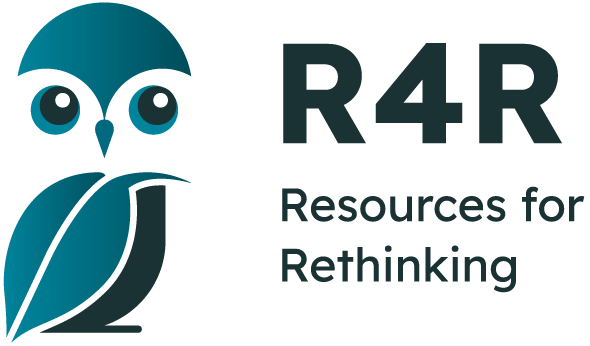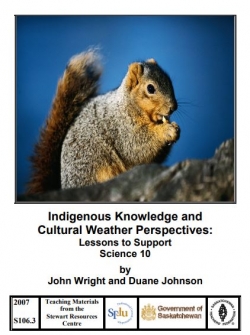- Home
- Tutorial
- Resource Guides
- Focus Areas
- LSF Programs
-
Professional
Development - Review Process
-
A project of LSF

Search for Resources
Indigenous Knowledge and Cultural Weather Perspectives
Lessons to Support Science 10
Secondary, Middle
Description
This four lesson resource was designed to support the Science 10 weather unit. Lessons examine cultural perspectives on weather and weather predictions with an emphasis on the Indigenous oral history of weather translating. Four activities are included to explore the idea that weather patterns can be identified using both traditional ecological knowledge as well as today's technology. Students review an oral history document summarizing First Nations weather translations, research and present other cultural weather sayings and complete a five-day homework project that involves making weather predictions based on the collection of personal weather data and the meteorological forecast of the day.
Lesson One: Introduction
After reviewing the terms weather and climate, students discuss questions which ask them to reflect on how sensory perceptions help to establish a knowledge base of the local environment so as to adequately prepare for the weather. They then make notes on First Nation's oral history which involves predicting weather using animal behavior and appearance, plant orientation, wind direction and astronomy.
Lesson Two: Cultural Weather Sayings Research
Students find the answers to guided questions on cultural weather sayings. They supplement computer research with information gathered from friends and family.
Lesson Three: Cultural Weather Sayings Sharing
After sharing the research gathered in lesson two, students work on a performance task for testing their comprehension of the cultural teachings.
Lesson Four: Weather Forecasting Journal
Students collect personal weather data (temperature, wind, cloud, plants, animals, astronomy) to predict weather. They compare their predictions to the meteorological forecast of the day.
General Assessment
What skills does this resource explicitly teach?
- Interpreting trends and patterns in data
- Critical thinking
- Selecting and integrating information from electronic sources
- Using various types of information to formulate predictions
Strengths
- Lesson are unique, sequential and easy to understand
- Excellent appendices and background information on traditional ecological knowledge and First Nations perspectives are provided
- Promotes an awareness and appreciation of the natural world
- Connects people and groups in the community
- Websites are included for research activities
- A list of extension activities are provided from Nelson Science 10
- Answer keys are provided for assessment/ research questions and a rubric is suggested for the weather journals
- The purpose of each activity is clearly stated
Weaknesses
- No authentic action project
- No authentic case studies
- No hands-on learning opportunities explicitly provided
- Students need more time to reflect and discuss their values and opinions
Recommendation of how and where to use it
This resource can be used to address outcomes in high school science courses associated with the study of weather and the art of weather forecasting. It could also be used as an enrichment project to emphasize the cultural importance of oral history, traditional ecological knowledge, and the use of both traditional and technological methods in dealing with the challenges of the 21st century.
Relevant Curriculum Units
The following tool will allow you to explore the relevant curriculum matches for this resource. To start, select a province listed below.
- Step 1Select a province
- Alberta
- Step 2Select a grade level
- Grade 6
- Step 3Select a subject
- Science
- Step 4Relevant matches
- Earth Systems: Understandings of the living world, Earth, and space are deepened through investigating natural systems and their interactions.
- Grade 10
- Step 3Select a subject
- Indigenous Studies
- Step 4Relevant matches
- Aboriginal Studies 10: Aboriginal Worldviews
- British Columbia
- Step 2Select a grade level
- Grade 7
- Step 3Select a subject
- Science
- Step 4Relevant matches
- Science 7: Earth and its climate have changed over geological time
- Grade 10
- Step 3Select a subject
- English/Language Arts
- Step 4Relevant matches
- English First Peoples - Literary Studies: The exploration of text and story deepens understanding of one’s identity, others, and the world.
- English First Peoples - New Media: The exploration of text and story deepens understanding of one’s identity, others, and the world
- Grade 11
- Step 3Select a subject
- English/Language Arts
- Step 4Relevant matches
- English First Peoples - Literary Studies: The exploration of text and story deepens understanding of one’s identity, others, and the world.
- Physical Education & Health
- Step 4Relevant matches
- Physical and Health Education - Outdoor Education: Spending time outdoors allows us to develop an understanding of the natural environment and ourselves
- Science
- Step 4Relevant matches
- Earth Science 11: The transfer of energy through the atmosphere creates weather and is affected by climate change
- Earth Science 11:The distribution of water has a major influence on weather and climate.
- Grade 12
- Step 3Select a subject
- English/Language Arts
- Step 4Relevant matches
- English First Peoples 12: The exploration of text and story deepens understanding of one’s identity, others, and the world.
- Physical Education & Health
- Step 4Relevant matches
- Physical and Health Education - Outdoor Education: Spending time outdoors allows us to develop an understanding of the natural environment and ourselves
- Social Studies
- Step 4Relevant matches
- B.C. First Peoples: The identities, worldviews, and languages of B.C. First Peoples are renewed, sustained, and transformed through their connection to the land
- Comparative Cultures 12: Understanding the diversity and complexity of cultural expressions in one culture enhances our understanding of other cultures.
- Contemporary Indigenous Studies: The identities, worldviews, and languages of indigenous peoples are renewed, sustained, and transformed through their connection to the land.
- Manitoba
- New Brunswick
- Newfoundland & Labrador
- Northwest Territories
- Step 2Select a grade level
- Grade 7
- Step 3Select a subject
- Science
- Step 4Relevant matches
- Science 7: Earth and its climate have changed over geological time
- Grade 10
- Step 3Select a subject
- English/Language Arts
- Step 4Relevant matches
- English First Peoples - Literary Studies: The exploration of text and story deepens understanding of one’s identity, others, and the world.
- English First Peoples - New Media: The exploration of text and story deepens understanding of one’s identity, others, and the world
- Science
- Step 4Relevant matches
- Experiential Science 10: Climatology and Meteorology
- Grade 11
- Step 3Select a subject
- English/Language Arts
- Step 4Relevant matches
- English First Peoples - Literary Studies: The exploration of text and story deepens understanding of one’s identity, others, and the world.
- Physical Education & Health
- Step 4Relevant matches
- Physical and Health Education - Outdoor Education: Spending time outdoors allows us to develop an understanding of the natural environment and ourselves
- Science
- Step 4Relevant matches
- Earth Science 11: The transfer of energy through the atmosphere creates weather and is affected by climate change
- Earth Science 11:The distribution of water has a major influence on weather and climate.
- Nova Scotia
- Step 2Select a grade level
- Grade 10
- Step 3Select a subject
- Indigenous Studies
- Step 4Relevant matches
- Mi'Kmaq Studies: Culture
- Mi’Kmaq: Education
- Science
- Step 4Relevant matches
- Science 10: Weather Dynamics
- Ontario
- Step 2Select a grade level
- Grade 9
- Step 3Select a subject
- Indigenous Studies
- Step 4Relevant matches
- Expressions of First Nations, Métis, and Inuit Cultures (Open): Art and Society
- Grade 10
- Step 3Select a subject
- Science
- Step 4Relevant matches
- Science (Academic):Earth and Space Science: Climate Change
- Grade 11
- Step 3Select a subject
- Indigenous Studies
- Step 4Relevant matches
- Contemporary First Nations, Métis, and Inuit Issues and Perspectives (univ./college prep.) Cultural Identity and Cultural Continuity
- World Views and Aspirations of First Nations, Métis, and Inuit Communities in Canada (College prep.): Understanding and Respecting World Views and Cultural Diversity
- World Views and Aspirations of First Nations, Métis, and Inuit Communities in Canada (Workplace prep.) Understanding and Respecting World Views and Cultural Diversity
- Grade 12
- Step 3Select a subject
- Indigenous Studies
- Step 4Relevant matches
- Contemporary Indigenous Issues and Perspectives in a Global Context, (Univ./College prep.): Indigenous Peoples and Perspectives
- Prince Edward Island
- Saskatchewan
- Step 2Select a grade level
- Grade 10
- Step 3Select a subject
- Indigenous Studies
- Step 4Relevant matches
- Native Studies 10: Community and Kinship: Aboriginal Perspectives
- Native Studies 10: Identity and Worldviews, Aboriginal Perspectives
- Science
- Step 4Relevant matches
- Science 10: Climate and Ecosystem Dynamics
- Yukon Territory
- Step 2Select a grade level
- Grade 7
- Step 3Select a subject
- Science
- Step 4Relevant matches
- Science 7: Earth and its climate have changed over geological time
- Grade 10
- Step 3Select a subject
- English/Language Arts
- Step 4Relevant matches
- English First Peoples - Literary Studies: The exploration of text and story deepens understanding of one’s identity, others, and the world.
- English First Peoples - New Media: The exploration of text and story deepens understanding of one’s identity, others, and the world
- Grade 11
- Step 3Select a subject
- English/Language Arts
- Step 4Relevant matches
- English First Peoples - Literary Studies: The exploration of text and story deepens understanding of one’s identity, others, and the world.
- Physical Education & Health
- Step 4Relevant matches
- Physical and Health Education - Outdoor Education: Spending time outdoors allows us to develop an understanding of the natural environment and ourselves
- Science
- Step 4Relevant matches
- Earth Science 11: The transfer of energy through the atmosphere creates weather and is affected by climate change
- Earth Science 11:The distribution of water has a major influence on weather and climate.
- Grade 12
- Step 3Select a subject
- English/Language Arts
- Step 4Relevant matches
- English First Peoples 12: The exploration of text and story deepens understanding of one’s identity, others, and the world.
- Physical Education & Health
- Step 4Relevant matches
- Physical and Health Education - Outdoor Education: Spending time outdoors allows us to develop an understanding of the natural environment and ourselves
- Social Studies
- Step 4Relevant matches
- B.C. First Peoples: The identities, worldviews, and languages of B.C. First Peoples are renewed, sustained, and transformed through their connection to the land
- Comparative Cultures 12: Understanding the diversity and complexity of cultural expressions in one culture enhances our understanding of other cultures.
- Contemporary Indigenous Studies: The identities, worldviews, and languages of indigenous peoples are renewed, sustained, and transformed through their connection to the land.
Themes Addressed
Air, Atmosphere & Climate (1)
- Weather
Ecosystems (1)
- Appreciating the Natural World
Indigenous Knowledge (1)
- TEK -- Traditional Ecological Knowledge
Science and Technology (1)
- Alternative Ways of Doing Science
Sustainability Education Principles
| Principle | Rating | Explanation |
|---|---|---|
| Consideration of Alternative Perspectives | Good | Although there is an emphasis on First Nations oral history, the resource explores the use of different types of cultural perspectives on weather and weather predictions. The resource also recognizes the merits of combining these with current technologies. |
Consideration of Alternative Perspectives:
| ||
| Multiple Dimensions of Problems & Solutions | Satisfactory | This resource introduces the use of indigenous knowledge to predict weather patterns and in doing so emphasizes the interconnections of society and the environment. |
| Multiple Dimensions of Problems & Solutions: Effectively addresses the environmental, economic and social dimensions of the issue(s) being explored.
| ||
| Respects Complexity | Satisfactory | This resource has thought-provoking activities which promote dialogue and discussion. |
| Respects Complexity: The complexity of the problems/issues being discussed is respected. | ||
| Acting on Learning | Poor/Not considered | There is no authentic action plan. |
| Acting on Learning: Learning moves from understanding issues to working towards positive change — in personal lifestyle, in school, in the community, or for the planet
| ||
| Values Education | Satisfactory | |
| Values Education: Students are explicitly provided with opportunities to identify, clarify and express their own beliefs/values. | ||
| Empathy & Respect for Humans | Satisfactory | The resource fosters respect for Indigenous knowledge and the emphasizes the importance of oral history in any culture. |
| Empathy & Respect for Humans: Empathy and respect are fostered for diverse groups of humans (including different genders, ethnic groups, sexual preferences, etc.). | ||
| Personal Affinity with Earth | Satisfactory | The tracking of weather easily accommodates outdoors experience. The resource certainly promotes the value of the natural world and the importance of preserving it. |
| Personal Affinity with Earth: Encourages a personal affinity with -the natural world.
| ||
| Locally-Focused Learning | Very Good | The completion of the weather journal brings relevance to the lives of the learner. |
| Locally-Focused Learning: Includes learning experiences that take advantage of issues/elements within the local community.
| ||
| Past, Present & Future | Good | This resource promotes both past and present methods for weather prediction. |
| Past, Present & Future: Promotes an understanding of the past, a sense of the present, and a positive vision for the future. | ||
Pedagogical Approaches
| Principle | Rating | Explanation |
|---|---|---|
| Open-Ended Instruction | Satisfactory | A combination of structured and guided inquiry is used. Students apply what they have learned to make their own predictions. |
| Open-Ended Instruction
: Lessons are structured so that multiple/complex answers are possible; students are not steered toward one 'right' answer. | ||
| Integrated Learning | Satisfactory | This is primarily a science resource, but there are opportunities for addressing outcomes in language arts, and social studies. |
| Integrated Learning: Learning brings together content and skills from more than one subject area
| ||
| Inquiry Learning | Satisfactory | |
| Inquiry Learning: Learning is directed by questions, problems, or challenges that students work to address.
| ||
| Differentiated Instruction | Satisfactory | Activities teach to both the cognitive and affective domains. There are no accommodations suggested for people with learning difficulties but appropriate groupings could help address this. |
| Differentiated Instruction: Activities address a range of student learning styles, abilities and readiness.
| ||
| Experiential Learning | Satisfactory | The weather journal does involve the collection of weather data, but most information is accessed via the internet and other media. |
| Experiential Learning: Authentic learning experiences are provided
| ||
| Cooperative Learning | Satisfactory | |
| Cooperative Learning: Group and cooperative learning strategies are a priority.
| ||
| Assessment & Evaluation | Satisfactory | Answer keys for reflection questions and the performance assessment tools are provided. There is also a rubric for the weather journal. |
| Assessment & Evaluation: Tools are provided that help students and teachers to capture formative and summative information about students' learning and performance. These tools may include reflection questions, checklists, rubrics, etc. | ||
| Peer Teaching | Satisfactory | |
| Peer Teaching: Provides opportunities for students to actively present their knowledge and skills to peers and/or act as teachers and mentors.
| ||
| Case Studies | Poor/Not considered | There are no thorough descriptions characteristic of case studies. The oral history of weather prediction is described in general terms only. |
| Case Studies: Relevant case studies are included. Case studies are thorough descriptions of real events from real situations that students use to explore concepts in an authentic context. | ||
| Locus of Control | Satisfactory | The students are given choices and options to explore in their weather journals. |
| Locus of Control: Meaningful opportunities are provided for students to choose elements of program content, the medium in which they wish to work, and/or to go deeper into a chosen issue. | ||

